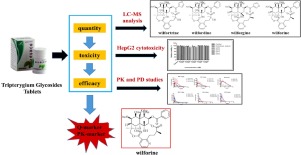Phytomedicine ( IF 6.7 ) Pub Date : 2018-03-19 , DOI: 10.1016/j.phymed.2018.03.031 Xue Gao , Xi Du , Lijun An , Yangyang Wang , Lili Wang , Zengguang Wu , Cong Huang , Xin He

|
Background
The quality standard of Tripterygium glycosides tablet (TGT) by CFDA can not fully reflect the effectiveness and safety. While, Q-marker was proposed to solve the problem of traditional Chinese medicine. PK-marker is mainly used to reflect the material exposure and the influencing factors of Chinese medicine after administration.
Purpose
Based on the study of quantitative analysis, cytotoxicity and pharmacokinetics, this study screened out and confirmed whether wilforine could be served as a potential Q-marker and PK-marker of TGT.
Methods
A sensitive and selective UPLC-MS/MS method was developed and applied to quantitative research of TGT preparation and pharmacokinetics study of TGT. Then, HepG2 cells assay was used to evaluate the cytotoxicity induced by alkaloids in TGT. Then, a PK-PD research was carried out in adjuvant arthritis (AA) rats and control rats after oral administration of TGT, with different dosage and timing. The pharmacokinetic characteristics were determined and calculated by DAS1.0. The pharmacodynamics of TGT was evaluated by the change of paw swelling through one-way ANOVA analysis.
Results
The quality of four alkaloids showed significant difference among four manufacturers, and they were abundant component in TGT from three manufacturers of all. HepG2 cells test revealed that wilforine and wilforgine could induce the cytotoxicity obviously. Pharmacodynamics index suggested that TGT had therapeutic effect on adjuvant arthritis. Thus, the four cases of death occurred in the high dose AA rat group had proven the significant toxicity caused by continuous high dose TGT administration. Furthermore, the result of pharmacokinetic study proved that Cmax, and AUC(0-tn) of wilforine have dose-dependent and time-dependent characteristics. But for wilforgine, there was no indication that there was an accumulation phenomenon in vivo and its plasma concentration showed low exposure. Therefore, it could hardly become the PK-marker of TGT.
Conclusion
Wilforine is proposed as a biologically active and toxic component of TGT that can be served both as Q-marker and PK-marker. The quality, clinical safety, and efficacy of TGT should be evaluated by the quality of wilforine.
中文翻译:

雷公藤多甙片的Q标记和PK生成者Wilforine:基于制剂的定量分析和PK-PD研究
背景
CFDA的雷公藤多甙片(TGT)的质量标准不能完全反映其有效性和安全性。同时,提出了Q-marker来解决中药问题。PK标记主要用于反映给药后中药的物质暴露和影响因素。
目的
在定量分析,细胞毒性和药代动力学研究的基础上,本研究筛选并确认了是否可以将野福林用作TGT的潜在Q标记和PK标记。
方法
建立了灵敏,选择性的UPLC-MS / MS方法,并将其应用于TGT制剂的定量研究和TGT的药代动力学研究。然后,使用HepG2细胞分析评估生物碱在TGT中诱导的细胞毒性。然后,对TGT口服给药的佐剂性关节炎(AA)大鼠和对照组大鼠进行了PK-PD研究,其剂量和给药时间不同。通过DAS1.0确定并计算药代动力学特征。通过单向ANOVA分析通过爪肿胀的变化评估TGT的药效学。
结果
四种生物碱的质量在四个制造商之间显示出显着差异,并且它们是来自三个制造商的TGT中丰富的成分。HepG2细胞试验表明,野福宁和野福宁能明显诱导细胞毒性。药效学指标表明TGT对佐剂性关节炎具有治疗作用。因此,高剂量AA大鼠组中发生的四例死亡已证明由连续高剂量TGT施用引起的显着毒性。此外,药代动力学研究的结果证明,wilforine的C max和AUC (0-tn)具有剂量依赖性和时间依赖性。但是对于野草碱,没有迹象表明体内存在蓄积现象并且其血浆浓度显示低暴露。因此,它几乎不可能成为TGT的PK标记。
结论
有人提议将Wilforine作为TGT的一种生物活性和有毒成分,既可以用作Q标记又可以用作PK标记。TGT的质量,临床安全性和疗效应通过碱的质量进行评估。































 京公网安备 11010802027423号
京公网安备 11010802027423号